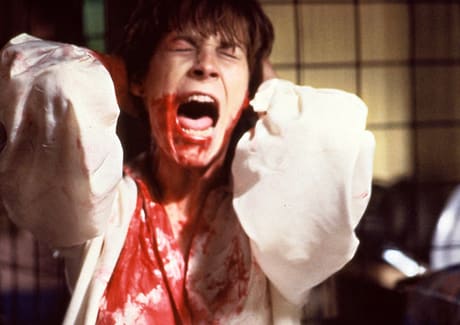This seemingly forgettable Halloween knock-off from the '80s, featuring libidinous teenagers getting hacked-up by a masked villain as revenge for a fraternity prank gone wrong years ago, in the context of the socio-political significance of horror cinema, which is now a fully analyzable genre, is somewhat fascinating for reasons beyond pure entertainment. The story can be summed up in a sentence or two. In the preamble, we see Jamie Lee Curtis roped into participating in a cruel joke from her fraternity friend/jerk extraordinaire Doc Manley (Die Hard's Hart Bochner). Of course, the prank goes wrong, the poor, naïve kid is humiliated and for years treated for mental trauma because of it. Cut to three years later, Curtis and the same group of pre-med students are partying it up on a New Year's Eve train ride, full of booze, pot and heated sexual libidos. When one of the students is killed before boarding the train, and whose costumed identity is assumed by the killer, we assume it's the same poor kid and that there's going to be a bloodbath. Curiously, the film is spare with its blood. Most of the kills are hidden from us, making it like a consciously PG version of the traditional slasher film. This specifically is interesting to examine from the point of view of the horror film history. Terror Train was made in 1980, making it one of the first modern teen slasher films. And if you look at Halloween (1978) and Friday the 13th (1980), explicit gore had yet to become a pre-requisite for the genre. As forgettable as the plotting and characterizations of the story are, for genre enthusiasts, the narrative deconstructs perfectly into the genre formula. The "inciting incident": a community of people responsible for an immoral act against the villain in the past; "location": An isolated environment disconnected from the outside world; "villain": a masked avenger burdened by the trauma of the past; and "twist": a whodunit mystery with misdirected cues and red herrings to the killer's identity. From a political point of view, this film was made in the heyday of the Canadian tax shelter film, produced entirely in Canada with American money, but independent of the studio system, though Fox would later acquire the film for U.S. distribution. The production values are surprisingly strong, especially the cinematography, lensed by the great John Alcott (famous for shooting Kubrick films such as Barry Lyndon and The Shining). It also happens to be Roger Spottiswoode's first feature, and his ability to choreograph suspenseful action within the tight space of an actual train shows remarkable talent. And even the performances manage to surmount the rickety material. John Ford and Sam Peckinpah stalwart Ben Johnson, as the heroic conductor, is the heart of the film and lends immeasurable credibility to the action, and Jamie Lee Curtis, as usual, oozes screen charisma from her pores. David Copperfield also gives a surprisingly good turn as a magician aboard the train who becomes the audience's main suspect. The Shout Factory Blu-Ray/DVD disc holds deep reverence for the picture, evidenced by the four well-produced and informative featurettes centering on the production reminiscences of then young production executive Don Carmody, U.S. producer Daniel Grodnik and the fine work of production designer Glenn Bydwell and composer John Mills-Cockell. Each of these men, while not claiming to have made fine art, take their work seriously; their candid enthusiasm is refreshing and infectious, aiding in the appreciation of this picture in the context of the genre.
(Shout! Factory)Terror Train
Roger Spottiswoode

BY Alan BacchusPublished Nov 5, 2012